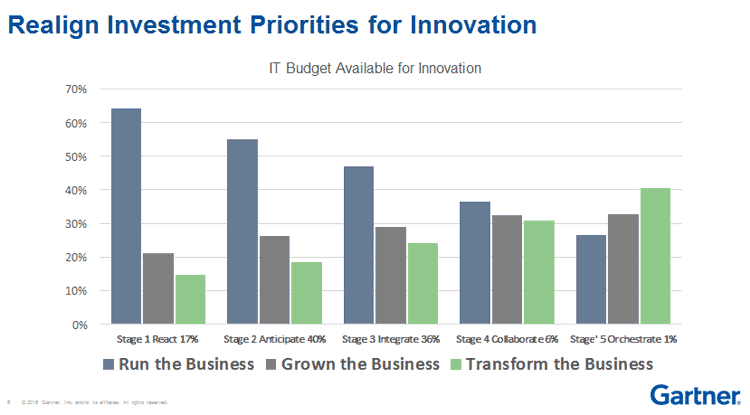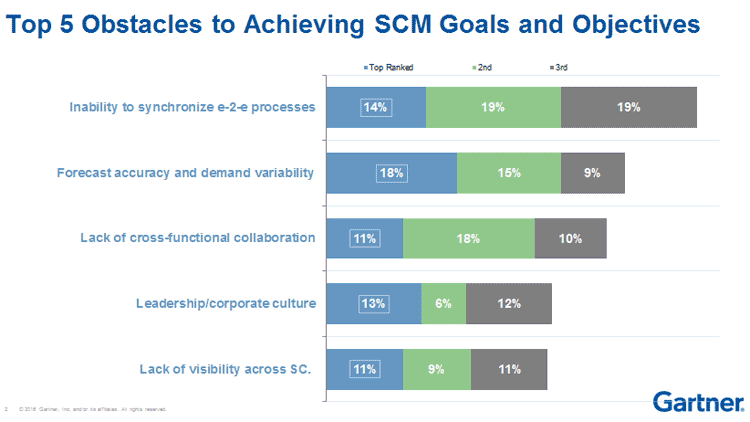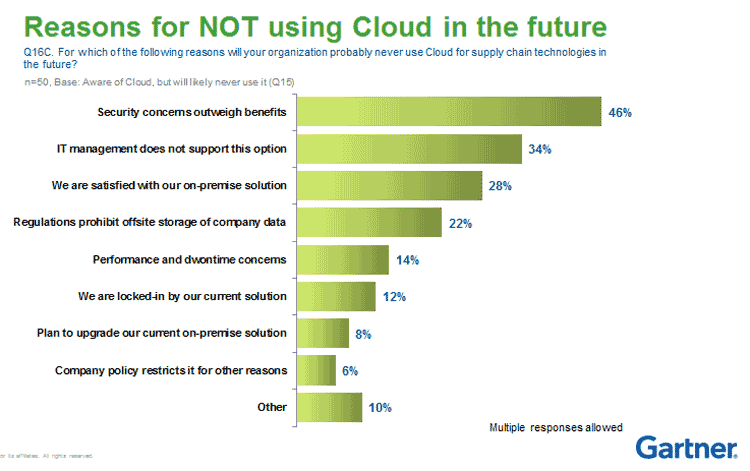For nine years now SCDigest has partnered with the analysts at Gartner on a supply chain study based on a survey of our readership.
Usually, the presentation highlighting the findings is first released at the Gartner Supply Chain Executive Conference in Phoenix, with the research led as usual by Gartner's Dwight Klappich. That didn't happen this year, and the research has instead been rather distributed across many presentations and research notes. However, I have pulled together as usual some of the highlights here.
Gilmore Says.... |
 |
| We will be conducting the 10th annual survey some time later this year - please share your input with us at that time, we need your help. |
 |
What do you say? |
|
| Click here to send us your comments |
| |
|
|
|
These days, a lot of what Gartner does is connected in some way to an ever-growing list of "maturity models," the first of which was a core supply chain framework, or more accurately a "Demand Driven Value Network " maturity model.
Released several years ago, the original model had four levels, but has now expanded to five. The basic concept has been spun out to similar maturity models for Sales & Operations Planning, Logistics and a few more areas.
If you aren't familiar with that DDVN model, the five levels are: Level 1 - React (business unit focused, often misaligned or siloed objectives); Level 2 - Anticipate (some supply chain functional performance improvements over Level 1); Level 3 - Integrate (integrated, cross functional supply chain decision-making); Level 4 - Collaborate (profitable demand-driven fulfillment through internal and some external collaboration); and Level 5 - Orchestrate (profitable shared value creation through innovation across internal/external networks).
Gartner will tell you very few if any companies are really at level 5.
That maturity model almost always becomes important with Gartner research and analysis because survey respondents are asked to self-rate themselves as being in one of those five levels, and then many of the responses are analyzed based on that segmentation. In this survey, 17% said they were Level 1, 40% Level 2, 36% Level 3 and 5% Level 4, and just 1% Level 5.
So, for example, is the chart you see below, which summarizes in what areas companies spend their supply chain IT dollars based on the level of maturity in the Gartner model. As can be seen, companies at lower levels of supply chain maturity tend to spend a lot more of their available IT budgets on "running the business" than they do on "transforming the business" versus more mature companies.

So why is this? Seems to me there are three possibilities: (1) lower maturity companies simply spend less on supply chain IT, and so innovation is just cut out of the dollar pool; (2) lower maturity companies are less efficient in IT spend, so they have to spend relatively more just to keep the ship moving; or (3) lower maturity companies just lack an innovation gene overall in their supply chain or even total company DNA, so it isn't a high priority.
Next, what barriers are stopping companies from reaching their supply chain goals?
The top 5 are listed below, with "inability to synchronize end-to-end processes" in total coming out on top, although perennial favorite "forecast accuracy and demand variability" actually had a higher percentage of respondents who selected it as the top barrier. Rounding out the top 5 from a long list of choices were (3) lack of cross functional collaboration, (4) leadership/corporate culture, and (5) lack of supply chain visibility.

This is really interesting when you think about it. What really - and I mean really - are the barriers to reaching supply chain goals and driving improvement? As I now think about it, I am not sure if inability to synchronize end-to-end processes is a cause or just a symptom. And to what extent is just an overall lack of modern supply chain technology a factor? (That wasn't one of the choices.)
Switching gears a bit, the results this year showed a strong interest in moving to Cloud-based supply chain solutions. In parallel with that, Gartner offered a continuum of software deployment models, which is as follows:
On-Premise: The traditional way applications have been deployed and operated for the last several decades. The customer buys and runs its own technical infrastructure and then purchases and installs and operates various applications on this infrastructure.
Hosted: Basically the same as on-premise but the customer outsources operation and maintenance to a third party that either operates applications on the customer infrastructure or moves these to the hosting providers infrastructure.
Private Cloud: A form of Cloud computing with closed access, a style of computing in which scalable and elastic IT-enabled capabilities are delivered as a service to internal customers using internet technologies.
Public Cloud: Externally managed computing services that multiple companies access and use. The Cloud service can range from IT infrastructure to business services and has options of dedicated public Cloud, community public Cloud, and network public Cloud.
Hybrid Cloud: A not often seen combination of on-premise and public Cloud services. For example some TMS providers operate the market-facing capabilities of their application in the Cloud but allow their customers to run their optimization engines on-premise or in the Cloud.
Dedicated Cloud: A vendor operates multiple instances of its application software where each customer has its own instance running on shared Cloud infrastructure.
Multi-tenant Cloud: A vendor operates a single instance of its application software for all customers.
Gartner asked survey takers what factors were driving them to the Cloud, but maybe more interesting are the reasons why companies are eschewing Cloud solutions, as shown the graphic below.

Not surprisingly - though perhaps a bit overblown versus non-Cloud risks - are issues around data security, followed by lack of general interest from the corporate IT group and then companies that are simply satisfied now with what they have.
There is a lot more from the study but I am out of room. If you would like a copy of the summary slide deck please give me a holler at here.
We will be conducting the 10th annual survey some time later this year - please share your input with us at that time, we need your help.
Any reaction to this Garter study data? What really are the barriers to improved supply chain performance? Why do more mature supply chains spend more on innovation? Let us know your thoughts at the Feedback section below.
Your Comments/Feedback
|